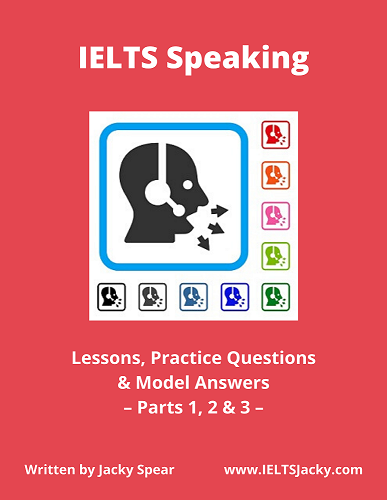IELTS
Speaking Samples
One of the resources most requested by students is IELTS Speaking samples for Part 2 of the test. But be warned, you could read hundreds of different sample talks without actually learning very much about how to create good answers yourself and achieving the score you want.
That’s not going to happen to you because the IELTS Speaking samples in this section of the website will teach you exactly how to develop excellent 2 minute talks that will gain you the marks you need.
However, just reading them and memorising the strategies won’t help you unless you actually practise using them over and over again. So, at the bottom of the page, I’ve included some IELTS-style cue cards for you to practise with and links to other pages with even more cue card topics.
The path to success
As we discovered on the introductory page on the Speaking test, the number one way to ensure success is to have a clear planning strategy that allows you to use your 1 minute planning time wisely.
If you haven’t read this important page yet, you’ll find it here:
IELTS Speaking Part 2 - 5 Reasons For Low Score & How To Avoid Them
Planning Strategies
Poor planning leads to an unstructured talk with ideas popping up all over the place and not really tying together. Fortunately, it’s an easy problem to solve.
So let’s begin looking at the actual strategies you can use to develop your answer in the 60 seconds you have before you start talking. One minute doesn’t sound long, but it’s long enough if you have a plan.
You’ll be given some paper to make notes and will be allowed to look at your notes while you’re talking. You won’t be marked on them.
On this page, I’m going to show you one simple strategy to use. You’ll find two more on these pages:
Want to watch & listen to this section?
Click on this video.
Method 1 – Using Question Prompts
For the first of our three IELTS Speaking samples, I’m going to use one of the cue cards you saw on the introductory page.
Describe something healthy you enjoy doing.
You should say:
- what you do
- where you do it
- who you do it with
and explain why you think doing this is healthy.
If your mind likes to work in a structured way, you’ll probably find this method the easiest to use.

Step 1 – First, pick out the keywords from the bullet points. I’ve underlined them for you here:
what you do
where you do it
who you do it with
and explain why you think doing this is healthy.
So, we’re
basically using the bullet points as they stand. However, it’s important that
you know these two things:
- You don’t have to use all the bullets points.
- You can talk about other
things as well.
You may find that you have plenty to say using the questions prompts ‘what’, ‘where’, ‘who’ and ‘why’ in the bullet points. In case you don’t have enough ideas, or one or more of the bullet points doesn’t fit with what you want to say about the topic, we’ll use the other two question words as well.
Here is the full list of all 6 question prompts:
- what
- where
- who
- why
- when
- how
I’ve underlined the two not included in these bullet points and we’ll also use these in the planning process.
You’ll find that some cue cards only use a couple of these question words. There's an example in the practise cue cards at the bottom of the page. Where this is the case, you’ll be especially glad of this list to help you extend your answer.
Step 2 – Next make some notes using each underlined word as a headline. Do this as quickly as possible, ideally in 30 seconds.
If you think of something you really want to say that doesn’t fit under these headings, just write an extra heading – other – and jot it down under this. The key is to stay focussed on the topic.
Sample notes for this cue card:
what
- circuit training
- different exercises – work whole body
- varies each week – makes it interesting
- sometimes do spin – really hard
where
- TM Fitness Factory
- Owned by Linda friend in club & son Tom
who
- members of my rowing club
- run by Chris, one of the members
when
- every Tuesday evening
how
- works every part of body
- aerobic fitness
- strong bones
why
- to improve fitness for rowing
- working out with other crew members creates team spirit
- would do if not rowing as like to keep fit & stay healthy
other
- can take it at your own level but like to push myself

Step 3 – Spend the remainder of your 1 minute planning time organising your notes.
Do these two things:
a) Decide which to talk about (you don’t have to use them all).
b) Put them in a logical order.
Here are our sample notes organised into a logical order.
circuit training
every Tuesday evening
members of my rowing club
TM Fitness Factory
owned by Linda, friend in rowing club, & son Tom
run by Chris, one of the members
varies each week which makes it interesting
different exercises – work whole body
aerobic fitness
sometimes do spin – really hard
working out with other crew members creates team spirit
can take it at your own level but like to push myself
would do if not rowing as like to keep fit & stay healthy
If you don’t have time to write them out again as I have here, write numbers beside them (1, 2, 3, 4...) to show the order in which you will talk about them. This will be enough to organise them in your mind.
When you first practise this method, give yourself plenty of time to make your notes as you get used to the technique. You'll soon get quicker. Gradually cut down the time you allow yourself until you can do in the 1 minute you'll have in the real Speaking test.
Step 4 – Give your talk.
You are now ready to give your 2 minute talk. Refer to your notes if you need to but it’s far better if you can talk without doing so. What you must not do is to read out your notes. Your speech will sound unnatural and won’t be fluent.
You'll also run out of things to say before the 2 minutes is up as you'll forget to develop each point as you're talking.
The process of making notes and organising them the way I’ve shown you should fix the ideas in your mind ready for them to flow as you start speaking. The more you practise, the better you will get.
Here's the first of our IELTS Speaking samples, created from the notes above. Can you see how it follows the order of the notes?
IELTS Speaking Sample
Describe something healthy you enjoy doing.
I’m a real fitness fanatic and do loads of things to stay fit and healthy but the one I’d like to tell you about is circuit training. I do this for an hour every Tuesday evening with a group from my rowing club.
We meet at TM Fitness, a gym owned by my friend and crewmate Linda and her son Tom. Tom actually runs the gym but we hire the hall and Chris, another of our rowers, leads the session.
The great thing about circuit training is that it involves lots of different types of activities so this keeps it interesting week by week. We’re never quite sure what we’ll be doing when we turn up.
With a conventional circuit, you work every part of the body in turn, doing aerobic activities and also body conditioning using weights. I like these types of circuits best. Sometimes, if there aren’t many of us there, we do a session on the spin cycles. This is really tough if you don’t get out on a bike very often as I don’t. I used to cycle a lot but don’t have time since I took up rowing. Anyway, spin is hard but I always feel good afterwards.
One of my favourite pieces of equipment is the punch bag. If you’ve had a stressful day at work, putting on a pair of boxing gloves and thumping the bag gets rid of all the negative energy.
I really enjoy exercising with other crew members from my rowing club. It helps to create a team spirit and we encourage and motivate each another. Our rowing club has members of all ages from teenagers to several people in their 60’s and everyone works out at their own level. I like to really push myself so that I get the most out of the session. There’s no point in going if you’re not going to get the greatest benefit out of it that you can.
There can be no doubt that circuit training keeps me aerobically fit and also gives me a strong body. Although I do it mainly to improve my fitness for rowing, I enjoy it so much that I think I’d still keep going even if I gave up rowing.
Would it matter if a few points were out of order in your talk? Of course not. Your notes are just a guide to help you along. Glance at them if you need to, to keep you on track and to help you to remember all your ideas. The most important thing is to talk naturally as if you were explaining things to a friend.

Preparing For Your Test
The ‘question prompt' method ensures that you quickly and easily come up with thoughts and ideas for your talk. The six prompt words are also simple to remember.
Now practise using this planning strategy yourself with these cue cards:
Describe an invention that has changed people’s lives.
You should say:
- what it is
- who invented it
- when it was invented
and explain how it changed people’s lives.
Describe a piece of good news you received.
You should say:
- what it was
- when you heard it
- where you heard it
and explain why you think it was good news.
Describe a piece of art you like.
You should say:
- what it is
- when you first saw it
- what you know about it
and explain why you like it.
Describe a book you have read.
You should say:
- what kind of book it is
- what it is about
- what sort of people would enjoy it
and explain why you like it.
Like this page?
Links To More IELTS Speaking Samples
Follow these links to two more planning strategies and IELTS Speaking samples:
Also visit this page for ideas on how to start your talk:
Part 2 Introduction: How to begin
your IELTS Speaking Part 2 talk & top tips for gaining extra marks.
There are more Part 2 cue cards and IELTS Speaking samples on the vocabulary topic pages. They also include examples of Part 1 & 3 questions and answers.
Vocabulary Topic Lists & IELTS Speaking Samples
Other Related Pages
IELTS Speaking Test: Know the format & understand what you’ll be assessed on. Discover the main reason for low scores & how to avoid this big mistake.
IELTS Speaking Part 1: 7 simple methods for developing your answers, with examples.
IELTS Speaking Part 2: Test format, understanding cue cards & 5 test mistakes to avoid.
IELTS Speaking Part 3: 6 common types of questions & how to answer them.
IELTS Speaking Topics: Discover 40+ common subject areas for the IELTS Speaking Test.
IELTS Speaking Practise Questions – Download 30 full mock tests (30 practise cards on 30 topics – 330 questions altogether).
IELTS Speaking Tips: 9 top tips to increase your chances of getting a high score
IELTS Speaking Practice: Massively improve your speaking skills by learning how to think in English.



















